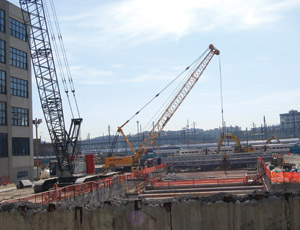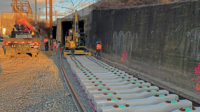PROJECT COST: $722 million
The tunnel boring machines chewing through Manhattan bedrock on a high-profile journey from E. 63rd St. to Grand Central Station have been getting most of the glory when New Yorkers hear about the $7.3 billion East Side Access program. But a challenging dig is also gearing in Queens, with two TBMs set to arrive this summer to slog through a mix of sand, fill, dirt, and boulders - all in a shallow water table.

The new drive is part of the $722 million Queens Bored Tunnels and Structures contract awarded last year to a joint venture of Granite Construction, Traylor Bros., and Frontier-Kemper to dig under Amtrak's Sunnyside Yard and Harold Interlocking, the busiest railroad interchange in the U.S. The team will create four 22-ft-dia precast concrete-lined tunnels covering 10,000 lin ft in an effort finishing in 2013.
The contract contributes a critical element to East Side Access, which is creating a new terminal below Grand Central to handle LIRR trains, which today travel to a congested Pennsylvania Station on the West Side. The Queens tunnels will link tracks on Long Island to the existing 63rd Street Tunnel under the East River. The overall project, which consists of 30 construction packages, is set to finish in 2016.
The Queens Tunnels contract initially was for $656 million, but the MTA added options and it now stands at $722 million. In addition to the primary dig, the scope includes reception pits for three tunnels, three emergency shafts, and completion of a previously started open-cut excavation.
Preparatory work began in September, but the "main event" is coming this summer with delivery of two 500-ton pressurized face "slurry" tunnel boring machines from German manufacturer Herrenknecht, says Stephen Price, project executive for Granite, the lead contractor.
Price says the custom-built TBMs are the first of their kind in the New York area, designed to handle various soils, including smaller runs of natural ground and bedrock, a larger amount of sandy-glacial material, a "fair amount" of boulders, uncertain obstacles from landfill, and possibly old concrete-reinforced wells.
A considerable challenge involves working around three other East Side Access contracts nearby. "This is a hotbed of activity," he adds.
Combine that with the task of not disturbing the churn of train travel on the yards and tracks above, and it's a massive effort, says Andy Thompson, program manager for East Side Access.
"Bringing together the multiple activities being undertaken under four other separate contracts to allow the tunnels to pass beneath the busiest interlocking in North America - and not impact the travelling public - is like building a Swiss watch," he says.
Key Players
Owner: MTA Capital Construction
Contractor: Granite Construction, Watsonville, Calif.; Traylor Bros., Evansville, Inc.; Frontier-Kemper, Evansville, Inc.
Program Manager: URS Corp, New York
General Engineering Consultant: PB Americas, New York; STV, New York; Parsons Transportation Group, New York
TBMs: Herrenknecht, Allmannsweier, DE
Secant Piles: Underpinning & Foundation Skanska, Maspeth, N.Y.
Dewatering, Excavation Support: Moretrench, Rockaway, N.J.
Temporary electrical substation: Total Electric
Environmental monitoring: Impact Environmental, Whitehouse Station, N.J.


Post a comment to this article
Report Abusive Comment